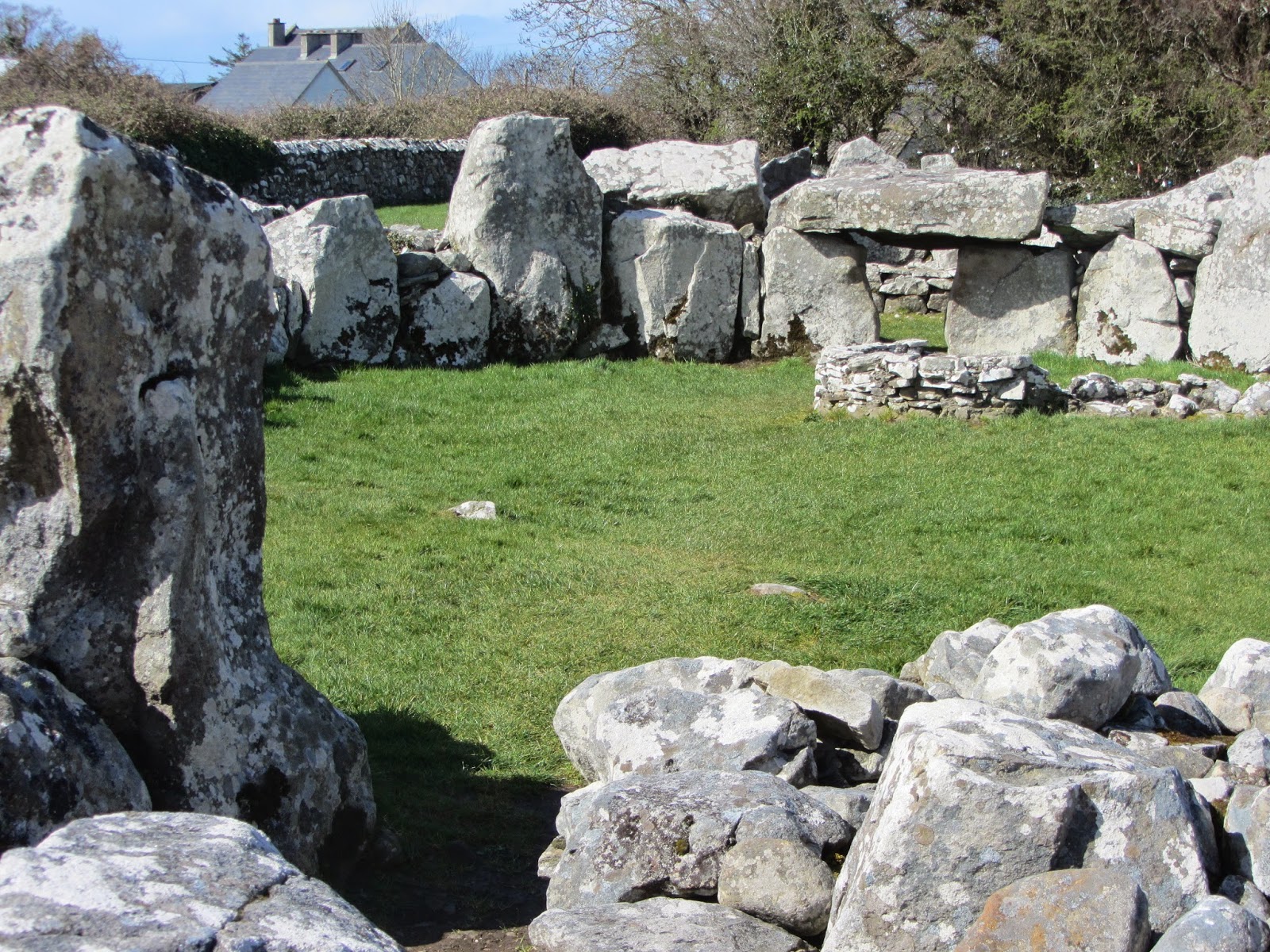 |
| Grave Slab 2 - Carrowntemple |
There were originally two enclosures around the Carrowntemple
complex but both are now partly demolished. The area of the inner enclosure is
0.4 ha. (1 acre) while the outer enclosure has an area of 6 ha. (15 acres). At
the centre of the inner enclosure are the remains of a plain medieval parish
church measuring 9.40m by 6.40m still standing 3.10m high. This church is
probably on the site of earlier wooden churches going back in time to the
foundation of the monastery. The church had a single-light east window.
 |
| Grave Slab 3 - Carrowntemple |
Over the years fourteen stone grave slabs, dating from the
early Christian period, were found mainly to the south and east of the church
within the old graveyard. In 1984 five of these slabs were removed from the
graveyard. These were recovered in 1986 and, later that year, the remaining
exposed slabs on site were taken into care by Sligo County Council.
 |
| Grave Slab 5 - Carowntemple |
Martin Timoney, archaeologist, states that the Carrowntemple
grave slabs are surprising in two ways:
“Firstly, how so many superb slabs did not come to archaeological
notice until 1973 is simply amazing. Secondly, some of the designs are
outstanding, even unique, for many reasons.”
 |
| Moylough Belt-Shrine |
 |
| Grave Slab 6 - Carrowntemple |
The Carrowntemple grave slabs raise interesting questions
about the transition between pagan Ireland and the arrival of Christianity. Edel
Bhreathnach’s excellent book “Ireland in the Medieval World AD 400-1000”
provides some valuable insights into this period.
The coming of Christianity to the island is traditionally
linked to St. Patrick, who is said to have converted the Irish during the early
fifth century. However, Palladius was sent by Pope Celestine a year earlier in
AD431, to minister as bishop ‘to the Irish believing in Christ’. Scholars
believe that the existence of Christian communities in Ireland was known to
Rome at this time.
Patrick left an account of his mission in two important
Latin documents, his Confessio, which
was a defence of his mission against critics in Britain, and his Epistola, a letter condemning a British
king, Coroticus, for attacking and enslaving some of his newly converted
Christian flock.
Christianity in early medieval Ireland was administered by
bishops, priests and abbots, some in orders, others who were lay people. All
kinds of church buildings were constructed from simple post and wattle structures
to larger stone churches and monumental enclosures.
The two prevalent burial types in Ireland from the late
centuries BC and early centuries AD were cremations and inhumations, with the
former more prevalent in the early period and inhumation becoming common into
the first millennium AD. Interestingly,
cremation did not become obsolete, and instances of this practice have been
dated to as late as the eight century.
For Christian and non-Christians alike, death, burial, and the
subsequent treatment of the dead, were purely matters for the family. The
Christian clergy were not involved at all and pagans and Christians were buried
alongside one and other in family graves.
However, during the fifth and sixth centuries, burial
practices for the nobility - clerics, kings and other aristocrats – began to
change. This was due to what has been described as the cult of saints. Early
Christians believed that by being buried near a holy grave they could hope to
stand beside the saint on the day of the resurrection. The practice of burying
people inside city walls developed, so that they could rest near the altars of
urban churches.
 |
| Grave Slab 10 - Carrowntemple |
It is not until at least the eight century, when the church exerted
its influence more widely, that it is possible to classify with some certainty
the difference between a Christian and non-Christian burial or cemetery.
The Christian rituals most prominent in St. Patrick’s Confessio and Epistola are the rites of baptism and confirmation which were rites
of passage and initiation. Christian baptism, conferred a new identity on
Patrick’s followers that, in the fifth century, would have probably set them
apart from their own society, thereby, creating a community within a community.
Scholars believe that wells were used instead of
baptisteries in Ireland, which may explain the proliferation of holy wells
throughout the country. Holy wells are thought to have been sacred places in
pre-Christian times and may have continued to be associated with non-Christian
rituals.
Carrowntemple, with its intricately carved Early Christian grave
slaps derived from the Celtic art of the preceding Pagan Iron Age, offers a
glimpse of the intersection of these two important periods in the history of Ireland.
For further information please see:
Bhreathnach, Edel, ‘Ireland in the Medieval World AD
400-1000’ (Four Courts Press 2014)
http://www.loughgaralakesandlegends.ie/carrowntemple-grave-slabs


























